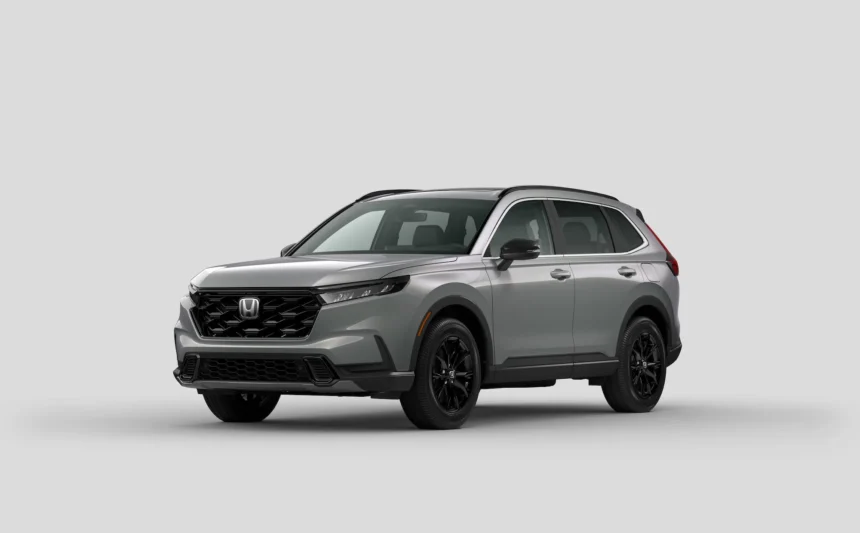The 2025 Toyota RAV4 and 2025 Honda CR-V are two of the most popular choices in the affordable family vehicle market. These crossover utility vehicles offer a perfect blend of efficiency, spaciousness, and versatility that appeal to families who do not need a third-row seat and want to keep costs low. Both the RAV4 and CR-V provide a car-like driving experience with a touch of ruggedness and higher ground clearance, making them ideal for small families.
One standout feature of the Toyota RAV4 lineup is the Plug-in Hybrid version, which boasts a powerful 302-hp hybrid system and an 18.1-kwh battery pack that allows for 42 miles of all-electric driving when fully charged. This model sets itself apart from the rest of the lineup and offers unmatched performance and innovation. On the other hand, the Honda CR-V lineup does not have a comparable plug-in hybrid option.
In terms of pricing and features, both the Honda CR-V and Toyota RAV4 start at around $30,000 for their base models and go up to about $40,000 for fully loaded versions, including high-mpg hybrids. The CR-V lineup includes the LX, EX, EX-L, and Hybrid models, with prices ranging from $31,000 for the base model to $42,000 for the Sport Touring Hybrid. On the other hand, the RAV4 lineup offers a wide range of front- or all-wheel-drive gasoline and Hybrid versions, starting at around $30,000 for the base LE and going up to about $41,000 for the Hybrid Limited AWD.
The CR-V and RAV4 differ in terms of size, with the CR-V being slightly longer and lower than the RAV4. The CR-V offers more cargo capacity with the rear seatbacks up or down, making it a more practical choice for families needing extra storage space. However, the RAV4 is slightly taller overall and in some versions has more ground clearance, making it a better option for those who need a more rugged vehicle.
Overall, both the 2025 Toyota RAV4 and 2025 Honda CR-V have their own unique strengths and appeal to different types of families. Whether you prioritize performance, innovation, pricing, or cargo space, these two models offer a compelling mix of features that make them top contenders in the affordable family vehicle market. The Toyota RAV4 and Honda CR-V are two popular compact SUVs that compete in the same segment. When it comes to cargo space, the CR-V takes the lead with about 39 cubic feet behind the rear seat and 76.5 cubic feet with it folded down. However, in real-world use, the CR-V’s seats do not quite yield a flat surface when folded, unlike the RAV4’s seats.
In terms of front-seat comfort, the CR-V offers more support and comfort compared to the RAV4. Additionally, the CR-V has larger door openings, making it easier to get in and out of the vehicle. Taller riders may find more headroom in the Honda due to its seating position and roofline.
When it comes to towing capabilities, the RAV4 has the upper hand, with models like the RAV4 Adventure and RAV4 TRD being able to tow up to 3,500 pounds. On the other hand, the CR-V Hybrid has a towing limit of 1,000 pounds, making it less suitable for towing heavier loads. The RAV4 Hybrid is rated up to 1,750 pounds, while gasoline models can tow up to 1,500 pounds.
In terms of off-roading capabilities, both the RAV4 and CR-V offer around eight inches of ground clearance in most forms. The RAV4’s all-wheel-drive system, especially in the Hybrid model, provides impressive finesse on snowy surfaces. However, the CR-V’s mechanical all-wheel-drive system is also capable, with different strengths and weaknesses compared to the RAV4.
Safety is another crucial factor to consider, and both the RAV4 and CR-V have good safety ratings. The RAV4’s crash-test scores are slightly better overall, and it has been named a 2024 IIHS Top Safety Pick. The CR-V, on the other hand, has a “Poor” rating in the updated moderate overlap frontal test by the IIHS. Both models come equipped with standard safety features like automatic emergency braking and adaptive cruise control.
In terms of performance, the CR-V’s 1.5-liter turbo-4 engine delivers 190 hp and 179 lb-ft of torque, paired with a CVT. The RAV4, with its 2.5-liter inline-4 engine producing 203 hp and 184 lb-ft of torque, comes with an 8-speed automatic transmission. Both SUVs offer hybrid versions that provide better performance, refinement, and fuel economy compared to their non-hybrid counterparts.
Overall, the Toyota RAV4 holds the advantage in towing capacity, off-roading capabilities, and safety ratings, while the Honda CR-V excels in front-seat comfort and cargo space. Both SUVs offer a mix of features and capabilities, catering to different preferences and needs in the compact SUV segment. The 2025 Honda CR-V and Toyota RAV4 are two popular choices in the compact SUV segment, offering a blend of performance, fuel efficiency, and technology. When comparing the two, there are some key differences that set them apart.
In terms of performance, the Honda CR-V delivers 204 hp and 247 lb-ft of torque in an electric-vehicle-like manner. The engine can be a bit strident on long hills, but overall, it provides a smooth and responsive driving experience. On the other hand, the Toyota RAV4 falls short in handling compared to the CR-V, with a less comfortable ride and a noisier cabin.
When it comes to fuel economy, both non-hybrid CR-V models and non-hybrid RAV4s offer similar combined mpg ratings, ranging from 28-30 mpg. However, the RAV4 Hybrid outshines the CR-V in efficiency, with most versions achieving 40 mpg combined. The RAV4 Plug-in Hybrid takes it a step further, offering 38 mpg combined and an impressive 42 miles of all-electric range on a plug-in charge.
In terms of interior, infotainment, and technology, both models offer Apple CarPlay and Android Auto connectivity. The RAV4 comes with a larger base touchscreen and offers a 10.5-inch screen in some versions. However, the Honda CR-V’s infotainment system is more user-friendly and intuitive, with better menu structure and layout.
When it comes to overall ambience and refinement, the Honda CR-V takes the lead. It offers a more upscale interior with better upholstery and a refined look and feel throughout the cabin. In contrast, the RAV4’s lower trims feel more budget-oriented, with a noticeable difference in materials and overall cabin ambiance.
In conclusion, while the Toyota RAV4 offers a wider range of trims and missions, including the Plug-in Hybrid option, the Honda CR-V wins out in terms of performance, comfort, and overall value for money. With a TCC Rating of 7.0 out of 10, the CR-V emerges as the better choice between the two, offering a more refined driving experience and a more luxurious interior.
Overall, the Honda CR-V comes out on top as the winner in this comparison, offering a superior blend of performance, fuel efficiency, and comfort. Whether you prioritize handling, fuel economy, or interior quality, the CR-V proves to be the better choice in the compact SUV segment. The rise of artificial intelligence (AI) has brought about significant changes in various industries, and one of the most impacted sectors is healthcare. AI has the potential to revolutionize the way healthcare is delivered, making it more efficient, accurate, and personalized.
One of the key areas where AI is making a significant impact is in diagnostic imaging. Radiology, in particular, is seeing major advancements with the help of AI-powered algorithms that can analyze medical images with incredible speed and accuracy. These algorithms are trained on vast amounts of data, allowing them to detect patterns and abnormalities that might be missed by human radiologists. This not only helps in early detection of diseases but also reduces the risk of misdiagnosis.
AI is also being used to streamline administrative tasks in healthcare facilities. Chatbots and virtual assistants are being employed to handle patient inquiries, schedule appointments, and even provide basic medical advice. This not only frees up healthcare professionals to focus on more critical tasks but also improves the overall patient experience by providing quick and efficient service.
In addition to diagnostic imaging and administrative tasks, AI is also being used in drug discovery and personalized medicine. By analyzing large datasets of genetic information and medical records, AI algorithms can identify potential drug targets and predict how individual patients will respond to different treatments. This has the potential to transform the way diseases are treated, making healthcare more tailored to each patient’s unique genetic makeup.
However, the adoption of AI in healthcare is not without its challenges. Issues such as data privacy, regulatory hurdles, and the ethical implications of using AI in patient care need to be carefully considered. There is also a concern about the impact of AI on healthcare jobs, with some fearing that automation could lead to job losses in the industry.
Despite these challenges, the potential benefits of AI in healthcare are undeniable. From improving diagnostic accuracy to personalizing treatment plans, AI has the potential to revolutionize the way healthcare is delivered. As technology continues to advance, it is essential for healthcare professionals, policymakers, and patients to work together to ensure that AI is used responsibly and ethically to improve patient outcomes and enhance the overall healthcare experience.







